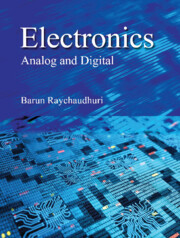Book contents
Summary
The most significant property of the p–n junction diode, as introduced in Chapter 3, is rectification or converting alternating current (ac) to direct current (dc) because the diode conducts under forward bias only. This property is utilized for fabricating rectifier circuits. The three major categories of rectifier namely half-wave, full-wave, and bridge are illustrated in this chapter. The rectifying property of a diode is also implemented to the transmission of a portion of an alternating voltage waveform. Such circuits, known as the clippers are elaborated. Two other important circuits, namely the clamper and the voltage multiplier that use diodes with capacitors are brought together.
Piecewise Linear Model
The diode is, of course, a nonlinear device because the current through it undergoes nonlinear change with voltage. Yet the diode can be approximated as a linear element part-by-part under certain conditions. The concept of such ‘linearizing the diode’, as explained with Figures 4.1(a) and 4.1(b), is quite useful to the analysis of the circuits containing diodes. Both the diagrams symbolize the forward current–voltage characteristic curve of a typical diode but at different scales. Figure 4.1(a) represents the enlarged view for the condition just after cut in. The current is now determined by the junction property and the nonlinearity of the current–voltage curve is quite prominent. The same diode at a forward voltage much higher than the cut-in voltage behaves like that of Figure 4.1(b) where the current is dominated by the bulk resistance of the semiconductor, the nonlinearity below 0.7 V gets squeezed into a small region of the characteristic curve and the major portion of the curve becomes linear.
The above demonstration implies that when the bias voltage becomes much larger than the forward cut-in voltage of the diode, the eBipolar Junction Transistorquivalent circuit can be represented by the combination of the following three pieces of linear circuit elements in series.
•An on/off switch representing the forward/reverse biased condition of the diode.
•A voltage source in lieu of the voltage drop across the diode.
•A resistor denoting the semiconductor bulk resistance.
Therefore, such an equivalent circuit of the diode is termed as the piecewise linear model of the diode. Figure 4.2 illustrates the action of this model. The switch (S) is the proxy of the forward and reverse-biased conditions of the diode.
- Type
- Chapter
- Information
- Electronics , pp. 101 - 140Publisher: Cambridge University PressPrint publication year: 2023



